
Exercise can help diabetics keep their blood glucose levels under control. A balance of cardio and resistance training is beneficial to everyone, diabetic or not.
Today more than 9 million Canadians are diabetic or prediabetic. Of those who’ve been diagnosed, 90 percent have type 2 diabetes, and the numbers are rising along with the rates of obesity. Fortunately, increased physical activity is an effective, side effect-free way of maintaining healthy glucose levels.
Get moving
The best thing you can do is maintain a balanced and healthy lifestyle that includes extra daily activity (such as taking the stairs whenever possible), resistance training, cardiovascular training, and stretching. This is applicable for everyone, by the way, not just for those living with diabetes or prediabetes.
The latest findings show that exercise such as strength training has a profound impact on diabetes management. In a recent study of Hispanic men and women, 16 weeks of strength training produced blood sugar control improvements comparable to taking diabetes medication. The side effects? The study volunteers gained muscle, lost body fat, experienced reduced rates of depression, and felt more self-confident.
Before starting a new fitness routine, discuss it with a qualified health care practitioner, and make sure you ask about blood sugar maintenance before, during, and after exercise.
Cardiovascular exercise
30 minutes, 90 seconds per exercise, 5 days per week
Foot problems are very common in those with diabetes. If you are experiencing foot problems due to diabetes, opt for the low intensity options provided.
Boxing
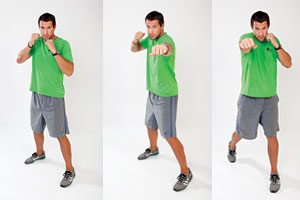
It helps to put on music with an upbeat tempo that is easy to follow.
- Make a fist with each hand and bring your hands up to your cheeks.
- With feet about shoulder width apart, bounce on your toes and shift your weight side to side in time with the music.
- Depending on what side you shift your weight to, throw a short, quick punch with the corresponding arm and return it to your cheek.
- Do the same on the other side and repeat.
For lower intensity
- Slow your pace to half speed and simply step to the sides rather than bounce.
Skipping
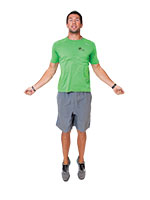
Depending on your access to equipment and skipping abilities, you can do this one with or without a rope. You can use the two-foot hop method, you can do the one-foot step-over method, or if you are a regular Muhammad Ali you can spice it up with a shuffle step.
For lower intensity
- Do a high knee march, but be sure to incorporate your arms to get that full body workout.
4 corners knee driver
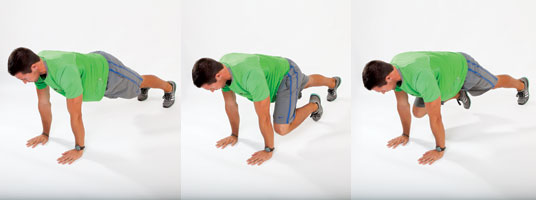
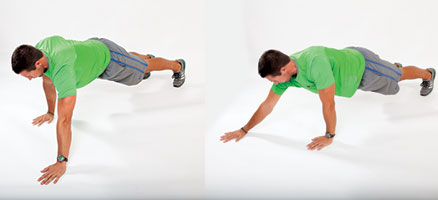
- Get into the top of a push-up position and imagine that there is a rectangular box around your entire body.
- Lift one foot slightly off the ground and bring the knee in toward your chest.
- Return to starting position, and complete the same motion with the other leg.
- After replacing the leg to starting position, pick up a hand and extend your reach as far as you can at a 45-degree angle from your body.
- Replace the hand to starting position and complete the same motion with the other one.
Star jacks
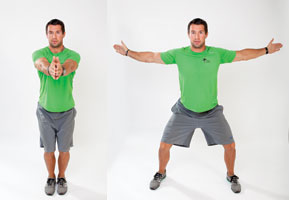
- Begin with your feet together and hands together extended out in front of you at chest height. Knees should have a slight bend to them.
- While jumping your feet apart just beyond shoulder width, open your arms out to your sides at shoulder height.
- Immediately jump your feet back together and bring your hands back to starting position.
For lower intensity
- Step one foot out to the side at shoulder width. As you step, open your arms as wide as you can.
- Close your arms and return your foot back to centre.
- Repeat with the other leg.
Resistance training
3 sets of 4 exercises, 15 reps each exercise, 3 days per week
Breathing is crucial during exercise, especially for those with diabetes. Holding your breath while resistance training can cause elevated stress and cortisol levels which, when combined with a raised internal pressure can put eyes, blood vessels, and lungs at risk. Exhale on exertion, inhale on return to start.
Reverse lunge and twist
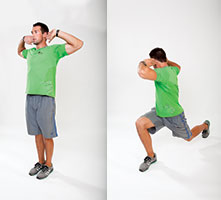
- With elbows extended out to the sides, touch your ears.
- From a standing position, take a large step backward with your left foot while the right stays in place.
- While keeping the heel of your right foot on the ground, drop the knee of your left leg until it hovers just off the ground.
- As you are dropping your knee, slowly twist your upper body to the right.
- Twist back to centre and step your left leg in to starting position.
- Complete the same motion with the other side, alternating legs as you go.
For lower impact
- Lessen the distance of your step back, only drop your knee halfway to the floor, and only twist your upper body half way.
Wheelbarrow walkouts
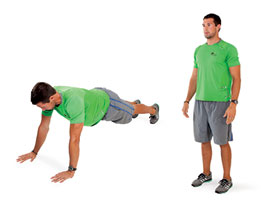
- Begin in a standing position with your arms at your side.
- Bend forward at the waist and place your hands on the ground in front of you.
- Slowly walk your hands forward until your body extends out to the top of a push-up position.
To increase the difficulty
- Include a push-up, or simply walk your hands back in to your feet and stand up to the starting position.
For lower intensity
- Complete the exercise from your knees.
Single leg dips
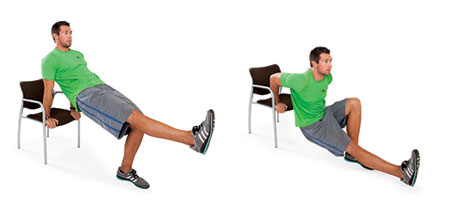
- Find a bench, chair, short wall, or elevated surface of 12 in (30 cm) or greater.
- Sit on the surface with your hands flat (palms down) beside your hips.
- When you have a secure hand position, walk your feet away from the surface until your bum is clear of the bench. Your knees should have a slight bend to them.
- Lift one leg slightly off the ground and dip your hips as close to the ground as possible, allowing your elbows to bend (do not lower lifted foot).
- Once at the bottom of your range, lift your hips and straighten your arms. That is one rep. Complete 10 to 15 reps on one leg and then 10 to 15 on the other.
For lower intensity
- Keep both feet on the ground and bend your knees to 90 degrees.
Resistance band lower back extensions with a lat pulldown
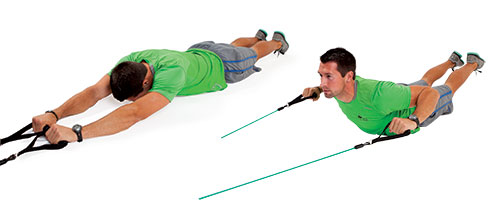
- Lay down face first on the ground with your arms extended out in front, legs extended behind, and a resistance band looped around an anchor point in front of you.
- Keeping your legs straight the whole time, hold one resistance band handle in each hand and pull your elbows down to your sides while raising both your chest and legs off the ground as high as you can.
- Return to starting position.
For lower intensity
- Break down the exercise into two motions: complete the pulldown first, then move into the lower back extension.
- Also, you can lessen the resistance provided by the band by moving closer to the anchor.
Stretching
- 45 seconds per stretch, for each major muscle, 6 days per week
Let’s be honest, nobody likes stretching. It’s the Tuesday of physical fitness and well-being. But it is critical to the health of those with and without diabetes alike. Focus on hamstrings, quadriceps, chest, back, and abdominals.




































